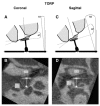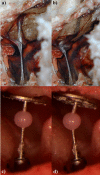Tympanoplasty - news and new perspectives
- PMID: 29279725
- PMCID: PMC5738936
- DOI: 10.3205/cto000146
Tympanoplasty - news and new perspectives
Abstract
Techniques and biomaterials for reconstructive middle ear surgery are continuously and steadily developing. At the same time, clinical post-surgery results are evaluated to determine success or failure of the therapy. Routine quality assessment and assurance is of growing importance in the medical field, and therefore also in middle ear surgery. The exact definition and acquisition of outcome parameters is essential for both a comprehensive and detailed quality assurance. These parameters are not the audiological results alone, but also additional individual parameters, which influence the postoperative outcome after tympanoplasty. Selection of patients and the preoperative clinical situation, the extent of the ossicular chain destruction, the chosen reconstruction technique and material, the audiometric frequency selection and the observational interval are only some of them. If these parameters are not well documented, the value of comparative analyses between different studies is very limited. The present overview aims at describing, comparing, and evaluating some of the existing assessment and scoring systems for middle ear surgery. Additionally, new methods for an intraoperative quality assessment in ossiculoplasty and the postoperative evaluation of suboptimal hearing results with imaging techniques are available. In the area of implant development, functional elements were integrated in prostheses to enable not only good sound transmission but also compensation of occurring atmospheric pressure changes. In combination with other components for ossicular repair, they can be used in a modular manner, which so far show experimentally and clinically promising results.
Keywords: PORP; TORP; middle ear mechanics; middle ear prosthesis; ossiculoplasty; outcome parameters; quality control; quality of life; tympanoplasty.
Conflict of interest statement
The authors declare that they were supported by Heinz Kurz Medical Technique Company during the last 3 years in the context of travelling grants and performed contract research.
Figures














References
-
- Wullstein H. Theory and practice of tympanoplasty. Laryngoscope. 1956 Aug;66(8):1076–1093. doi: 10.1288/00005537-195608000-00008. Available from: http://dx.doi.org/10.1288/00005537-195608000-00008. - DOI - DOI - PubMed
-
- Zollner F. Surgical technics for the improvement of sound conduction after radical operation. Arch Ital Otol Rinol Laringol. 1953 Jul-Aug;64(4):455–468. - PubMed
-
- Hüttenbrink KB. Die Funktion der Gehörknöchelchenkette und der Muskeln des Mittelohres. In: Feldmann H, Ganzer U, editors. Teil I: Referate. Verhandlungsbericht 1995 der Deutschen Gesellschaft für Hals-Nasen-Ohren-Heilkunde, Kopf- und Hals-Chirurgie. Berlin, Heidelberg: Springer; 1995. Available from: http://dx.doi.org/10.1007/978-3-642-79553-4_1. - DOI - DOI
-
- Hüttenbrink KB. Zur Rekonstruktion des Schallleitungsapparates unter biomechanischen Gesichtspunkten. [Biomechanics of Middle Ear Reconstruction]. Laryngo-Rhino-Otol. 2000;79(S2):S23–S51. doi: 10.1055/s-2000-15917. (Ger). Available from: http://dx.doi.org/10.1055/s-2000-15917. - DOI - DOI
-
- Zahnert T. Laser in der Ohrforschung. Laryngo-Rhino-Otol. 2003;82:157–180. doi: 10.1055/s-2003-38931. Available from: http://dx.doi.org/10.1055/s-2003-38931. - DOI - DOI - PubMed
Publication types
LinkOut - more resources
Full Text Sources

